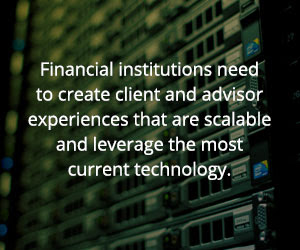
Over the past twenty years, large financial service organizations made technology development decisions based on two options: either to design, build and implement the technology themselves; or look externally to acquire and install existing solutions from a small number of large vendors and service organizations. The choice then was to build or to buy.
1990s
Building was the most common strategy for most large organizations. Everything from account opening and trading to statements and confirms, was built on mainframe technology and customized for each firm.
The resulting technology was highly integrated into the organization’s internal systems – finance, compliance and regulatory applications – and over time these connections deepened and became more complex.
Building technology allowed firms to control the roadmap, development, risk and cost of their core platforms, and while their evolution was relatively slow, they managed to keep pace with the market. Technology outsourcing was for the most part, restricted to operating systems (Windows) and office productivity tools (Microsoft Office).
2000s
The rapid technology change through the late 1990s placed significant pressure on the internal solutions to keep up with the evolving market. At the same time, the development of third party enterprise solutions for core functions – CRM, reporting, compliance monitoring, trading, etc. – emerged as a viable buy option to the in-house build strategy.
The buy model allowed firms to leverage technology vendor research and development capabilities and offset development costs. Integration of the newly acquired solution into the existing legacy systems was a challenge, but the buy option provided more flexibility and choice than internal builds.
The ongoing maintenance requirements of the acquired technology were also less than the build strategy, but firms still had to factor in support, training and upgrades/replacement costs over the entire product lifecycle.
Today and Tomorrow
The pace and scope of change in technology are accelerating. Everything from mobile adoption, processing power and broadband capacity to application design, hardware capability and data storage is evolving at an unprecedented rate.
Technology is enabling new market entrants to disrupt traditional markets faster than ever before. Robo advisors, digital banks, P2P lending and payments processing through an application can move from startup to global market disruption in a couple of years. The wealth management equivalent of Uber and AirBnB is coming to the industry.
What will it look like? Nobody knows. But what is becoming more apparent, is that the requirement to retain maximum strategic flexibility in order to adapt changing technology is critical. Legacy systems, in-house platforms and applications that financial institutions built or acquired, will be significantly challenged to deliver this flexibility to constantly compete in this new technology arms race.
Therefore, the evolution of strategy may have moved from building and buying to simply renting the technology. Renting allows an organization to outsource the hosting, development, infrastructure and maintenance of the solutions. While client data, privacy and security can still be a concern, most established vendors provide full security and control infrastructure.
Build, Buy or Rent?
There will likely be a place for the build model in the future for very large brokerage firms, but it will represent an ever-larger risk and investment from the firm.
Buying technology will also be an option, mostly for hardware and infrastructure, but less for software and operating systems.
The renting model will likely be the most popular one as it appears to be the best way to remain flexible and evolve fast enough to keep up with technology.
Want to know more? Download the white paper.